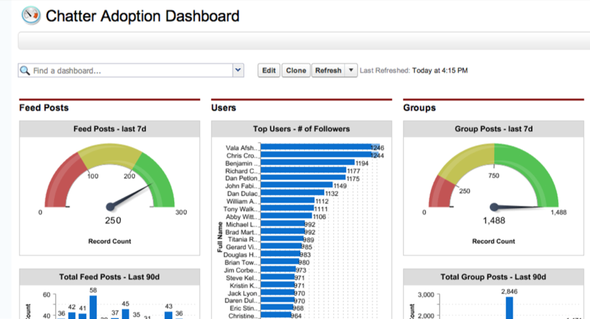2013
Autospeak-Straight Talk contains articles covering digital and social media marketing social communities and events marketing
 What is the common thread in the following statistics? Thirty-six percent increase in brand awareness, 66% less time to bring products to market, 20% improvement in customer conversions, 15% increase in successful innovations and new ideas?
What is the common thread in the following statistics? Thirty-six percent increase in brand awareness, 66% less time to bring products to market, 20% improvement in customer conversions, 15% increase in successful innovations and new ideas?Answer: These are just some of the quantitative results attributed to becoming a social business. With dramatic benefits like these, why aren't all businesses social by now? The fact is, becoming a social business can be quite difficult, especially without a well-thought-out implementation plan.
Today, social software and tools have made cross-functional collaboration easier than ever before but cultural and philosophical barriers still get in the way. Even with all the well-demonstrated benefits of collaboration -- improved internal and external communications, better use of constrained budgets, better customer relationships and shorter meetings -- the concept of the social business introduces elements of threat, loss of control and risk. For managers accustomed to hierarchical control, fully embracing social business can mean moving outside their comfort zone.
[ Want a better bottom line? Read Social Collaboration's Big Payoff: Increased Sales. ]
There exists a digital divide in business. On one side of the divide are those who view technology as a distraction, something that must be closely monitored and controlled. On the other side are those who embrace the technology megatrends of social, mobile and cloud. To innovate and thrive in today's rapidly changing environment, businesses must become social and bridge this digital divide.
To that end, here is a seven-step checklist for becoming a successful social business -- a checklist that has worked well for us at Enterasys.
1. Define A Meaningful Purpose.
Start by understanding where you want to go. Make sure everyone's goals are aligned. Your company culture will play an enormous role in becoming a social business, so take the time to understand and steer your company's culture in the right direction. If your people are not comfortable, they'll drop into what Christine Comaford calls their critter state. Provide the right company environment and you can move them into their collaborative smart state.
Make sure everyone sees the benefits of a social business. It won't mean more work; it will mean less email, fewer interruptions, less guesswork, fewer meetings. It will make work life more innovative and more fun.
2. Simplify The User Experience.
Ensure the tools for social business are easy and fun. They will get used as long as they are simple and integrate well into the general work environment and daily routine. At Enterasys, we use Salesforce.com and most employees keep it open and available on their desktops. When Chatter became available as a social communication tool integrated with Salesforce, it was a natural fit that helped speed adoption.
Be sure to encourage the use of online and mobile tools such as Evernote, wikis and blogs for taking meeting notes. That way the notes can be posted, shared and even edited immediately. Include social handles in all tools and interactions to make their use as easy as possible. Today people tend to keep Tweetdeck open on their desktop or mobile device and use it almost as often as email. Some people have completely switched from email to Twitter.
Becoming a social business rarely requires redesigning the organization. In fact, social businesses tend to avoid frequent reorganizations. The social tools are the lubrication that keeps cross-departmental and cross-functional information flowing freely, reducing the separation between groups.
3 Designate A SOCIAL Executive Sponsor.
Gartner estimates that 80% of social business projects will not achieve their intended benefits due to inadequate leadership. The executive leader must be S.O.C.I.A.L. -- sincere, open, collaborative, interested, authentic and likeable. Find -- or create -- an executive sponsor who meets these criteria: You're Not a Social Business Leader If ______? (10 Hints).
In some companies, the CMO might be the executive sponsor. Or it might be the VP of services or the chief customer officer. In a small startup, it might even be the CEO. Consider whether your company needs a chief social officer. The key is to find the most likeable, collaborative individual who has a large-scale influence -- and by the way, that might not necessarily be an executive. Embracing collaboration throughout a company requires participation and support from senior leadership. You are not a social business if your CEO and her direct reports are not actively using social technologies to collaborate and engage.
4. Trust Your People!
You have hired only trustworthy people, so trust them. Don't overanalyze corporate social collaboration guidelines. When you're trying to accomplish something revolutionary, it's best not to have too many variables, or you'll end up with analysis paralysis. Constraining interaction can have even worse consequences. Make sure everyone understands the concepts of the digital footprint and digital citizenship. A little awareness of these concepts goes a long way. There is some risk to eliminating filters and barriers, but the benefits of open collaboration outweigh these risks.
One of our early lessons involved senior management using Chatter to talk about non-work related subjects, including topics that showcased their personalities and interests. We came to realize that this was important. By bolstering employees' personal brands, you help bolster their work.
5. Implement And Drive Engagement With Social Tools.
Make social adoption a team sport. Create social collaboration functional groups. Every group has innovation leaders; pull them in early and enlist their help in engaging others. Try gamification techniques. Rethink your processes to include social tools. It doesn't have to be perfect the first time. Social businesses are agile, able to learn from their mistakes and pivot quickly.
At Enterasys, we wanted to use Salesforce Chatter to champion collaboration and promote the work of others. Our CEO, Chris Crowell, decided that the most important thing he could do to advocate collaboration was to share sales wins via Chatter. Chris would specifically name the salesperson and the customer and provide details about our sales victories. The entire company knew when we won, and the sense of pride and unity helped instill a positive attitude. Growth starts with this mindset.
To keep building momentum, provide "Lunch & Learns" or better yet, hold Google Hangouts for training on social media and collaborative software. Interactively delve into topics like the latest in social media tools and the art of tweeting and share best practices.
Enterasys uses a number of innovative social business activities to drive implementation. We hold frequent social "jams" built around Google Hangout to roll out new social initiatives. Trivia contests, where the responses must be submitted via Twitter, have helped increase employee engagement. We post tips and best social media practices to a wiki, which everyone can add to and edit. We are introducing "Flashback Thursdays," where we re-post past photos and blogs to reinforce earlier training.
6. Measure Adoption And Recognize Achievements.
Provide as much real-time feedback as possible. Analyze connections. See where it's working and where it's not. As Peter Drucker said, "What's measured improves." Let everyone know when assessments are coming so no one is surprised.
During our implementation, we wanted to measure adoption in order to promote the early adopters. The tracing and measurement became a vehicle to identify who was embracing collaboration. It was important for us to set the tone and manage the grassroots movement through positive intervention. Here is an example of the Chatter reporting dashboard.

By Vala Afshar
DealerNet Services
CALENDAR
CATEGORIES
TAGS
TWITTER POSTS
CALENDAR
No IMGY selected.
- powered by
- One Big Broadcast
- creative by
- WebStager
© 2025 One Big Broadcast | All rights reserved
